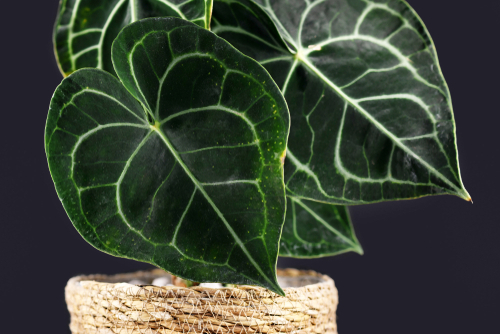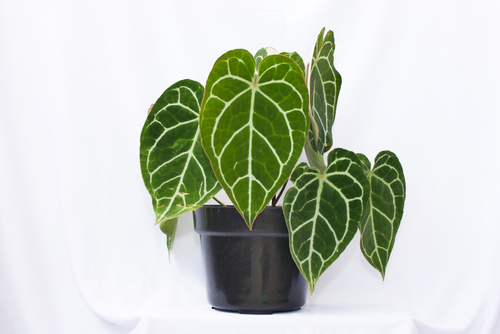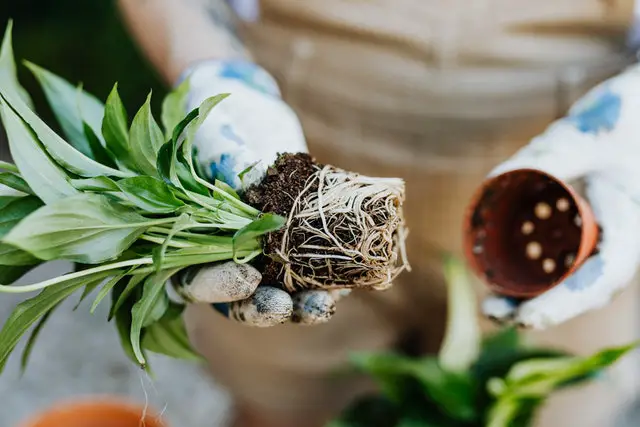Did you know that Anthurium plants come in 1,000 varieties that boast different shapes, sizes, and colours? But, it is necessary to understand the variations that these plants produce in order to choose the one that is the best suit for you. Crystallinum and clarinervium are two that many people mistake for each other, which is why this crystallinum vs clarinervium comparison is here to educate you on their differences and similarities!
Anthurium Crystallinum vs Clarinervium: An Overview

The main differences between these two houseplants show in the appearance and colour of their leaves, the colour of their berries, and the speed of their growth.
A. crystallinum comes with slim, elongated leaves in the colour of bright green, its berries range from white to violet, and it takes less time to grow than its sibling.
On the other hand, A. clarinervium has dark green leaves that are broader in appearance. As for the colour of its berries, it’s a lovely orange hue. Those berries need more time to mature than those of the crystallinum plant because they’re larger.
Related posts:
- Variegated Odora Plant, Grow & Care Guide 2022
- Calathea Yellow Fusion Plant, Grow & Care Guide 2022
- Anthurium Crystallinum Plant, Grow & Care Guide 2022
A Quick Comparison Between Anthurium Crystallinum vs Clarinervium
| Plant | Crystallinum | Clarinervium |
| Leaf color | Bright green with light green veins | Dark green with white veins |
| Stem Color | Green, brown, and reddish -brown | Light green, dark green and different shades of brown |
| Variegation | Pink, tan, and yellow parts on the leaves | Lime-green and yellow parts on the leaves |
| Flower | Produces yellow-green or white flowers | Produces violet or pale-green spadix |
Crystallinum vs Clarinervium Differences
Despite how similar they look to the untrained eye, A. crystallinum vs clarinervium are different in several regards. These include name, appearance, colour variants, leaf size and texture, growth rate, and more.
Let’s discuss each point in more detail right below!
1. Origin and Name
In the case of A. crystallinum, you should know that it sometimes goes by Crystal Anthurium. It’s native to the rainforests of Central and South America.
On the other hand, A. clarinervium is best known as Velvet Cardboard Anthurium. It mainly grows in Chiapas, Mexico.
As we’ve already established, both belong to the Anthurium genus of the Araceae family.
2. Taxonomy
Even though they share the same genus and family, these two plants have some slight differences in their taxonomy details.
A. Crystallinum Taxonomy
- Kingdom: Plantae
- Phylum: Spermatophyta
- Class: Monocotyledonae
- Order: Arales
- Family: Araceae
- Genus: Anthurium
A. Clarinervium Taxonomy
- Kingdom: Viridiplantae
- Phylum: Streptophyta
- Class: Magnoliopsida
- Order: Alismatales
- Family: Araceae
- Genus: Anthurium
3. Shape & Appearance
At first glance, both plants appear almost identical. Yet, their differences show once you take a closer look at them.
To be more specific, crystallinum plants have narrower leaves, looking almost oval. On the other hand, clarinervium leaves are broader and heart-shaped.
4. Differences in Colour
The foliage of the crystallinum plants comes in a unique bright green hue that’s patterned with light green veins. As for the stems, you’ll often find them in green, brown, red, or reddish brown.
On the contrary, clarinervium plants boast leaves that are a darker shade of green, and the lush colour is streaked with white veins. Here, you’ll find the stems mostly green or brown.
5. Leaf Size and Texture

Crystallinum leaves are much narrower, longer, and thinner than those of its sibling. They’ll normally be around 30 inches in length and 20 inches in width.
Plus, the leaves have a sheen to them that makes them appear polished.
As for clarinervium, you’ll notice that it has smaller yet broader leaves, with dimensions of only 12 inches in length and eight inches in width. Those leaves are also thicker and less prone to damage.
In addition to that, each leaf has a velvety texture, which explains the reason behind the plant’s more common name: Velvet Cardboard Anthurium.
6. Height and Growth Rate
A. crystallinum can reach a height of 30 to 60 inches as an adult houseplant. It also has a relatively faster growth rate in comparison to clarinervium, but its growth rate is moderate compared to other houseplants.
Alternatively, A. clarinervium only gets as tall as 25 inches indoors. It has a much slower growth rate than A. crystallinum.
7. Flowers
The crystallinum plant produces flowers in clusters on the stem, which usually come in shades of off-white or yellow-green. Yet, those blooms aren’t exactly attractive, so a lot of people cut them off to maintain the beautiful shape of the plant’s foliage.
Clarinervium plants produce violet or pale green spadix instead of flowers. Most people aren’t fans of these either!
Crystallinum vs Clarinervium Similarities
Because crystallinum and clarinervium plants belong to the Anthurium genus, they typically have similar requirements to grow into their beautiful adult selves.
If you take a look at their light, water, temperature, humidity, soil, and fertilization needs, you’ll get what we’re talking about!
1. Sunlight
Both Anthurium plants require exposure to bright, indirect sunlight to grow healthily. This translates to six to eight hours of sun in a bright room without being in the direct path of the sun’s rays.
Or, you can keep your plants next to a window where the sunlight streams through. Just make sure you protect these two houseplants from the harsh light by letting down sheer curtains.
2. Watering
The watering needs for crystallinum and clarinervium plants are the same, too.
You should water both of them once or twice a week in normal weather conditions. If the weather is too hot and the soil is 25% dry, you can up your game to three times a week.
3. Humidity & Temperature
Because both plants have tropical origins, you must replicate the climate of their homelands to help them grow into pretty houseplants.
Both thrive in temperature levels between 70 and 80 degrees Fahrenheit, give or take a degree or two. As for their humidity, make sure it doesn’t go lower than 65 to 70% because they like moist air.
4. Potting and Soil

Crystallinum and clarinervium plants need well-draining, loose, and slightly acidic soil. Going for soil with poor drainage or thick clay might cause root rot.
As for the perfect potting mix, an orchid mix should do in this case.
5. Fertilizer
The fertilization requirements are also identical in these two lovely plants.
To elaborate, both need to be fertilized during the growing season every 45 to 60 days. Plus, the fertilizer must include high amounts of phosphorus, nitrogen, and potassium, with twice as much phosphorus as the other two elements.
6. Natural Habitat
Both crystallinum and clarinervium call the same tropical regions home. They grow naturally in Mexico, especially in the southern part of the country.
However, it’s still worth mentioning that A. crystallinum spreads even lower in the depths of Central America.
Common Problems for Both Plants
Because of the many things that they have in common, crystallinum and clarinervium plants share the same set of problems. These include unhealthy leaves, limping stems, or pest infestations.
1. Curled, Spotted, or Yellow Leaves
Both plants are prone to suffer from curled, spotted, or yellow leaves. But, what’s the reason behind this?
Usually, weak-looking leaves are caused by overwatering, under-watering, low humidity in the air, or stress due to overly high or low temperatures.
2. Faded Leaves
Another issue that these two plants tend to face is faded leaves, which keeps them from looking fresh and healthy.
Oftentimes, the reason behind faded, dull leaves is the lack of water or moisture in the air surrounding the plant.
3. Limping Stems
Limping stems and leaves are sometimes caused by Rhizoctonia, which is a fungus that likes to stick to roots and the lower parts of stems.
This fungus causes the stems to become waterlogged, which results in a droopy, limp appearance.
4. Infestation of Insects and Mites
Crystallinum and clarinervium are subject to many types of pests, including spider mites, aphids, mealybugs, scale, and whiteflies.
Thankfully, those annoying little creatures are easy to get rid of once you detect them running along the plants. Just spray them with water to shake them off.
More stubborn insects or mites can be deterred by spraying the plants with neem oil.
To Wrap It Up
Now that you’ve read our crystallinum vs clarinervium comparison, it’s a bit easier to tell these two Anthurium species apart, right?
A. crystallinum has longer leaves that come in bright green with a sheen to them, not to mention that it has a faster growth rate. On the other hand, A. clarinervium appears with broad, heart-shaped leaves that are dark green, and its growth rate is much slower.
Good luck identifying those two houseplants!
Frequently Asked Questions
What is the difference between clarinervium and crystallinum?
As we’ve previously mentioned, clarinervium and crystallinum are different when it comes to the colour, texture, and shape of their leaves.
Crystallinum has elongated bright leaves that have a leathery feel to them. On the contrary, clarinervium is known for its broad, heart-shaped velvety leaves that are darker in colour.
What is the difference between Anthurium magnificum and crystallinum?
The main difference between these two Anthurium species shows if you take a closer look at their petioles.
While the petioles of A. magnificum are winged, those of A. crystallinum are almost cylindrical.

Hey, I’m Lisa and I’ve been an avid gardener for over 30 years. I love writing, talking and living in the garden! Feel free to connect with me on my socials below

